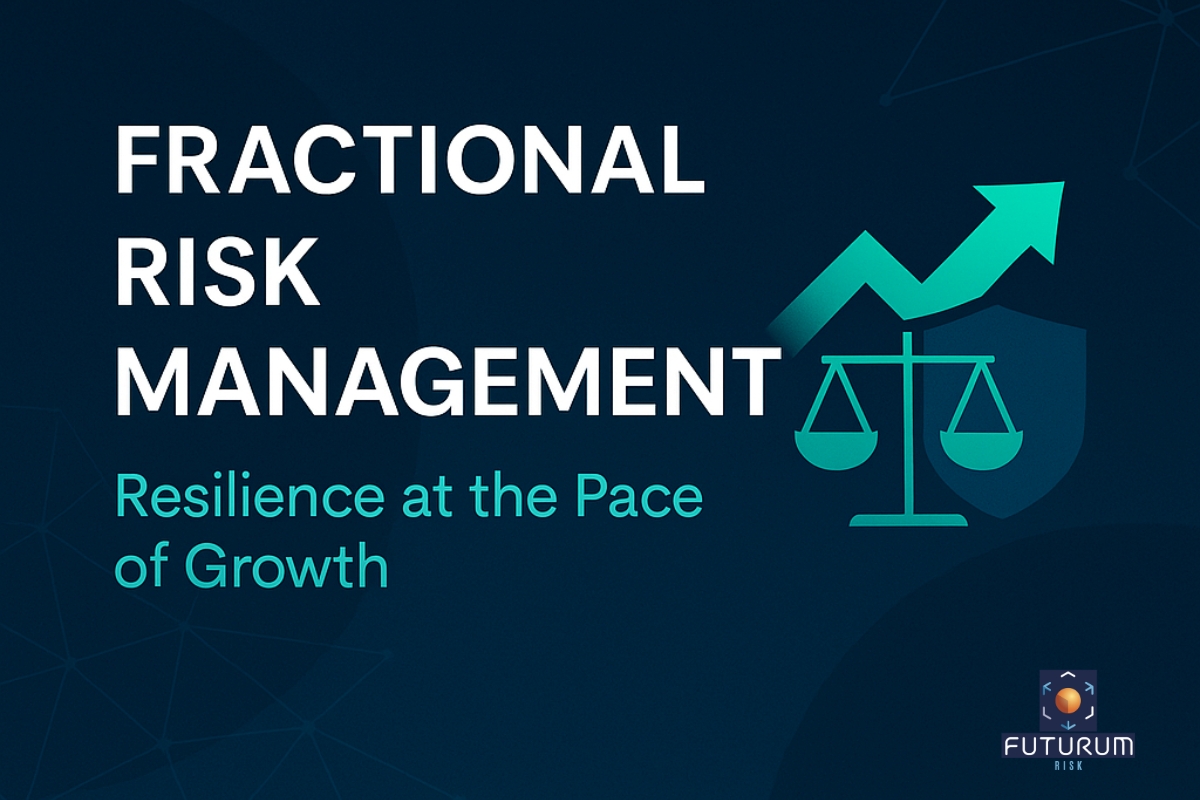Growth is never just about opportunity. It also brings complexity, new exposures, and decisions that carry real consequences. Many businesses cannot justify a full in-house risk team at an early stage, but they also cannot afford to leave risks unmanaged.
This is where fractional risk management comes in. It is important to understand what it is, why it is becoming more relevant, and how it gives companies a practical way to stay resilient without slowing down growth.
Fractional Risk Management: Building Resilience Without Slowing Growth
Growth is the dream of every ambitious company. New customers, expanding markets, bigger teams, and stronger partnerships are the milestones leaders strive for. Yet growth also carries weight. Each new hire introduces potential conduct risks. Every vendor contract brings exposure to third parties. Each deal or expansion decision carries financial and geopolitical uncertainty. Traditional approaches to risk management, such as building a full internal team or outsourcing to large consultancies, often do not fit the pace, scale, or budget of a growing business.
Fractional risk management offers an alternative. It allows companies to access experienced risk professionals in a part-time, embedded model, ensuring essential safeguards are in place without the heavy cost or bureaucracy of a permanent department. This article explores the concept in depth: what fractional risk management is, why it matters in today’s environment, how it draws from established frameworks, and how it can be applied across the most pressing risk domains. The aim is to educate leaders and provide a foundation for understanding how fractional approaches can strengthen resilience.
Defining fractional risk management
Fractional risk management is the structured practice of engaging highly experienced risk leaders or specialist teams on a part-time, flexible basis. These professionals are embedded directly within the organisation, participating in internal meetings, aligning with strategic goals, and delivering tangible outcomes. Unlike external consultants who provide reports and leave, fractional teams stay close to day-to-day operations, ensuring that recommendations are put into practice and adjusted as the business evolves.
The model is built around three principles:
- Proximity to decision-making so risk managers are present when growth decisions are made.
- Outcome orientation where success is measured in real results, such as faster client onboarding, fewer vendor failures, or improved audit outcomes.
- Flexibility of scale where support expands during high-pressure periods, such as fundraising or due diligence, and contracts when stability returns.
Fractional risk management gives companies the assurance of structured governance and controls without the financial or cultural burden of building a permanent, fully staffed risk department too early.
Why fractional risk management is gaining traction
Rising complexity in the business environment
Modern organisations operate in an environment shaped by interconnection and volatility. Supply chains stretch across multiple regions, vendors handle sensitive data in the cloud, and clients demand faster onboarding with fewer errors. The speed at which risks can spread across these networks has increased dramatically. A small vendor’s security failure or a sudden regulatory change in a foreign market can ripple through an entire business.
Increase in third-party and supply chain risks
Recent industry studies confirm the scale of the challenge. In 2024, over one-third of reported data breaches were linked to third-party suppliers or partners. The number is rising each year, demonstrating how dependent organisations have become on ecosystems they do not fully control. A fractional risk function helps companies introduce systematic vendor due diligence and continuous monitoring without requiring the same level of resourcing as multinational enterprises.
Global compliance expectations
Data protection and financial crime regulations have become mainstream in most jurisdictions. The European Union’s GDPR, California’s CCPA, Brazil’s LGPD, and a host of other frameworks illustrate a global shift toward tighter oversight. Companies are expected to demonstrate that they understand their risks and have proportionate safeguards in place. For smaller or growing firms, meeting these standards often seems daunting. Fractional professionals bring the knowledge of global norms, adapt them to the company’s size, and ensure compliance without unnecessary complexity.
Demand for efficiency
Perhaps the most compelling driver is efficiency. Investors, boards, and enterprise clients increasingly look for risk maturity as part of their decision-making. Demonstrating strong but lightweight controls can accelerate funding, reduce friction in sales cycles, and build trust with partners. Fractional models provide a way to deliver this credibility without overspending.
How fractional teams align with established frameworks
Risk management is not new. Decades of practice have produced established frameworks such as ISO 31000, COSO ERM, and the NIST Risk Management Framework. These standards remain invaluable, but they can be overwhelming for smaller organisations. Fractional teams act as translators, borrowing the elements that fit the company’s stage and ignoring unnecessary weight.
- ISO 31000 provides guiding principles and a lifecycle approach: identifying, analysing, treating, and monitoring risks. A fractional team uses these principles to create a unified process across departments.
- COSO ERM emphasises the integration of risk into strategy and performance. This lens is crucial for boards and executives who need to see risk not as a barrier but as a component of growth decisions.
- NIST RMF and ISO/IEC 27001 offer structured ways to manage information security. Fractional teams often adopt their language and practices to assure customers and regulators that sensitive data is handled appropriately.
- NIST AI RMF provides a forward-looking framework for managing emerging risks around artificial intelligence. As more businesses adopt AI tools, fractional teams can help implement safeguards to prevent bias, misuse, or compliance failures.
The strength of fractional risk management lies in selectivity. Teams implement what matters most for the company’s context and maturity, building a foundation that can expand later if required.
Key domains where fractional risk management adds value
1. Managing people risk during growth
When companies expand rapidly, recruitment processes can become rushed. A fractional risk function introduces structured employee screening that balances speed with protection. Role-based risk matrices determine which checks are appropriate for each level of responsibility, while clear decision rubrics ensure fairness and compliance. The outcome is a hiring process that supports fast growth while safeguarding against fraud, misconduct, or reputational damage.
2. Counterparty vetting and client onboarding
Onboarding clients and partners is a critical moment. Delays cause frustration, but insufficient checks can expose the organisation to financial crime, fraud, or regulatory issues. Fractional risk professionals establish Know Your Counterparty/Vendor processes that unify client and partner vetting. By tiering requirements according to risk, they enable low-risk counterparties to onboard quickly while ensuring higher-risk ones receive the scrutiny they deserve.
3. Vendor due diligence
Modern businesses rely heavily on vendors, from cloud providers to logistics partners. A single failure can disrupt operations or expose sensitive data. Fractional teams design vendor classification systems that identify which suppliers are critical, which are important, and which are standard. Each category carries different due diligence requirements, ranging from basic questionnaires to full evidence packs including certifications, security audits, and contractual safeguards.
4. Financial due diligence for deals
Growth often involves new deals, partnerships, or investments. Each carries financial risk. Fractional specialists bring financial due diligence expertise to screen counterparties, review deal structures, and highlight red flags. Their role is to protect margins and cash flow without unnecessarily delaying business opportunities.
5. Cybersecurity and data protection
Cyber risk is no longer a niche concern. Even small firms store sensitive data and rely on connected systems. Fractional teams adopt best practices inspired by global standards, including access controls, backup procedures, incident response plans, and privacy registers, to create a basic but reliable security posture. This approach reassures clients and partners that the business takes information protection seriously.
6. Geopolitical and macro-environmental risks
Organisations increasingly face uncertainty linked to global events. Supply chain disruptions, regulatory changes, or regional instability can all impact operations. Fractional teams help leaders track relevant geopolitical developments, maintain country risk heatmaps, and prepare trigger-based response playbooks. The goal is not to predict every event but to ensure the business is ready to adapt when circumstances shift.
The concept of “risk debt”
A useful way to think about risk is through the lens of risk debt. Similar to technical debt in software development, risk debt accumulates when teams prioritise speed and delay implementing controls. Some debt is acceptable if it enables faster delivery, but it must be tracked, acknowledged, and managed. Fractional teams help organisations quantify their risk debt, make deliberate trade-offs, and plan repayment by implementing the right safeguards at the right time.
Avoiding pitfalls
Fractional risk management is not a silver bullet. Poorly designed arrangements can lead to problems. These include:
- Policies without practice that fail to influence behaviour.
- Over-controlling arrangements slow business unnecessarily.
- Framework theatre where terminology is adopted without substance.
- One-off assessments that treat risk management as a project rather than a continuous process.
Experienced fractional teams avoid these pitfalls by embedding into operations, using proportionate controls, and emphasising continuous improvement.
Building resilience as you grow
One of the greatest strengths of fractional risk management is its ability to grow with the company. At an early stage, a fractional pod might introduce simple screening, a lightweight vendor questionnaire, and a basic risk register. As the business matures, the same team can expand the framework to include board-level reporting, comprehensive cyber safeguards, and sophisticated financial diligence processes. In this way, the model provides continuity without forcing organisations to overinvest before they are ready. Fractional risk management is not only about reducing threats, it is also about creating a structure that supports confident decision-making and sustainable expansion.
Why the Fractional Model Matters Now
Fractional risk management represents a pragmatic evolution in how organisations approach resilience. It bridges the gap between the cost of permanent teams and the detachment of external consultancies. By embedding expertise where it matters most, focusing on proportionate safeguards, and delivering measurable outcomes, fractional teams turn risk management into a genuine enabler of growth.
Companies that adopt this model position themselves not only to withstand uncertainty but also to seize opportunities with confidence.





